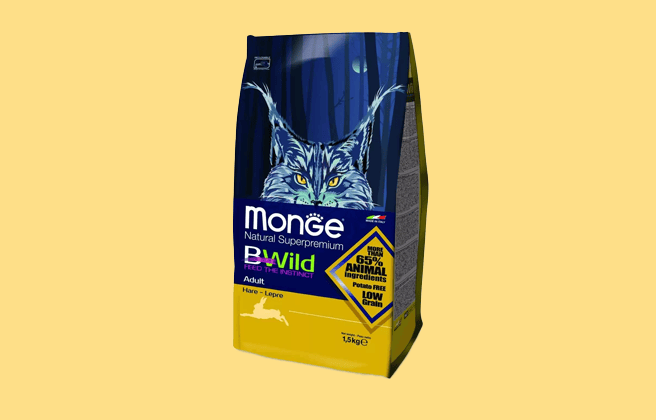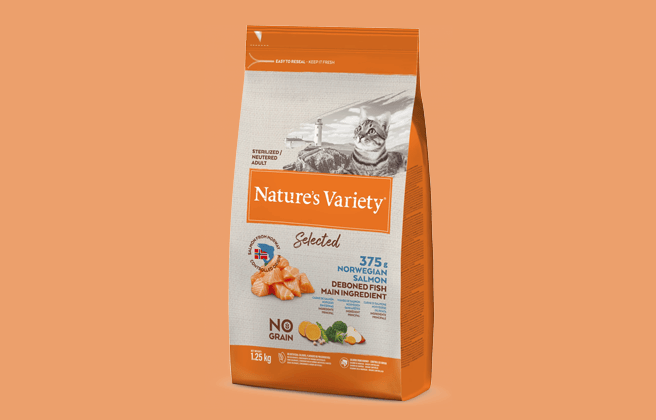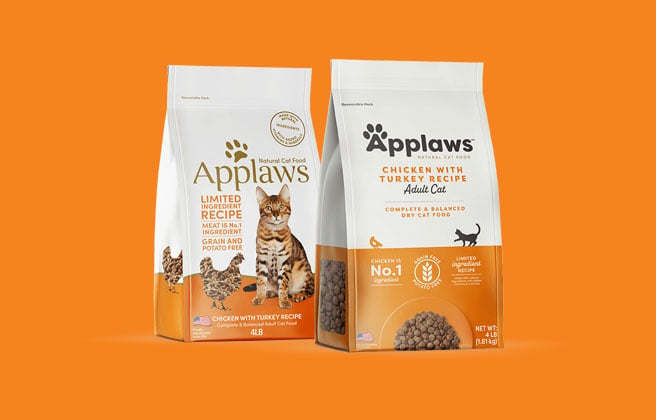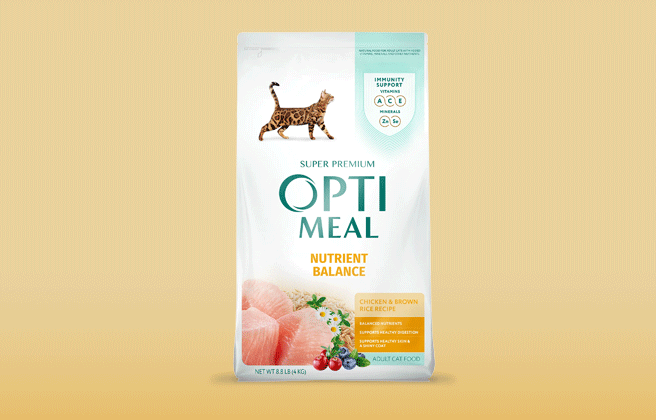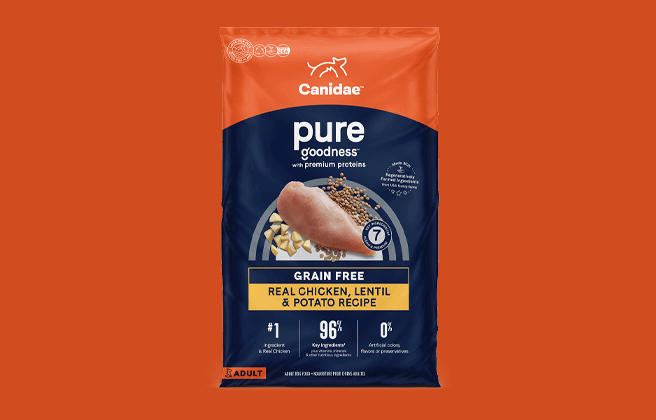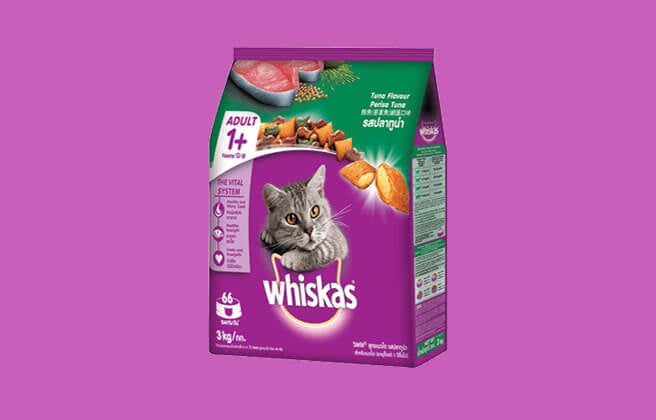
Our Verdict
Whiskas dry product range is made up of four recipes which all receive the Cat Food Advisor rating, 2 stars.
This range of food lists the first ingredient as whole grain cereals (corn and wheat) and also contains poultry by-products. With low protein content and being high in carbohydrates, this should be considered when evaluating this food.
Pros
- Relatively inexpensive versus some cat foods
- Well known brand
Cons
- Contains poultry by-products
- Includes corn and wheat
- Low in protein
- High in carbohydrate
- Contains artificial colours and antioxidants
The table below shows each recipe in the range including our rating and the AAFCO nutrient profile: Growth (kitten), Maintenance (adult), All Life Stages, Supplemental or Unspecified.
| Product line | Rating | AAFCO |
|---|---|---|
| Whiskas® Dry Food Adult with Tuna | 2 | M |
| Whiskas® Dry Food Adult with Chicken | 2 | M |
| Whiskas® Dry Food Adult with Grilled Salmon Steak | 2 | M |
| Whiskas® Dry Food Adult with Ocean Fish | 2 | M |
Recipe and Label Analysis
Whiskas® Dry Food Adult with Tuna recipe was selected to represent the other products in the line for a detailed recipe and nutrient analysis.
Label and nutrient data below are calculated using dry matter basis.
Whiskas® Dry Food Adult with Tuna recipe
Estimated Dry Matter Nutrient Content
Protein
Fat
CarbsCarbohydrates
Wholegrain cereals (corn, wheat), poultry and poultry by product, soybean product (full fat soybean, soybean meal), corn gluten meal, vegetable oil (palm stearin, soy oil) , ocean fish, wheat flour, minerals, iodised salt, vitamins, taurine, methionine, colorants (titanium dioxide, tartrazine, sunset yellow, indigo carmine), preservatives (antioxidants, potassium sorbate), flavour (tuna flavour).
Fiber (estimated dry matter content) = 5%
Red denotes any controversial items
Ingredients Analysis
The first ingredient is whole grain cereals. Whole grains or foods made from them contain all the essential parts and naturally-occurring nutrients of the entire grain seed in their original proportions. If the grain has been processed (e.g., cracked, crushed, rolled, extruded, and/or cooked), the food product should deliver the same rich balance of nutrients that are found in the original grain seed.
This definition means that 100% of the original kernel — all of the bran, germ, and endosperm — must be present to qualify as a whole grain 1. There are 14 grain species which can be defined as whole grain cereals. Depending on the grains included, the nutrients supplied can vary hugely. Whole grain cereals do not give us much information about the particular ingredient included in this food. Generally, whole grain cereals contain fibers, carbohydrates, vitamins and minerals. Aside from its energy content, however, this whole grain cereal is of only modest nutritional value to a cat.
The second and third ingredients are poultry and poultry by product, or slaughterhouse waste. This is what’s left of slaughtered poultry after all the prime cuts have been removed.
In addition to organs, this item can also include feet, beaks, undeveloped eggs and almost anything other than prime skeletal muscle.
The quality of this ingredient can vary, depending on the caliber of the raw materials obtained by the manufacturer.
Although this item contains all the amino acids a cat needs, we consider poultry by-products slightly lower in quality than a single species item (like chicken by-products).
The fourth ingredient is soybean product. Even though soybeans contain over 80% protein, this ingredient would be expected to have a lower biological value than meat.
And less costly plant-based products like this can notably boost the total protein reported on the label — a factor that must be considered when judging the actual meat content of this food.
We rarely consider soy a preferred component in any cat food.
The fifth ingredient is corn gluten meal. Gluten is the rubbery residue remaining once corn has had most of its starchy carbohydrate washed out of it.
Although corn gluten meal contains 60% protein, this ingredient would be expected to have a lower biological value than meat.
And less costly plant-based products like this can notably boost the total protein reported on the label – a factor that must be considered when judging the actual meat content of this cat food.
The sixth ingredient is vegetable oil, a generic oil of unknown origin. The ratio of omega-6 to omega-3 fats in any oil is nutritionally critical and can vary significantly (depending on the source).
Without knowing more, it’s impossible to judge the quality of an item so vaguely described. However, compared to a named animal fat, a generic vegetable oil cannot be considered a quality ingredient.
The seventh ingredient is ocean fish. This item is typically sourced from clean, undecomposed whole fish and fish cuttings of commercial fish operations. 2
Unfortunately, the phrase “ocean fish” is vague and does little to adequately describe this ingredient. Since some fish are higher in omega-3 fats than others, it’s impossible for us to judge the quality of this item.
In any case, fish meat is naturally rich in the eleven essential amino acids required by a cat to sustain life.
The eighth ingredient is wheat flour, a highly-refined product of wheat milling. Like corn, wheat is an inexpensive and controversial cereal grain of only modest nutritional value to a cat.
For this reason, we do not consider wheat a preferred component in any cat food.
From here the list goes on to include a number of other items. But to be realistic, ingredients located this far down the list (other than nutritional supplements) are not likely to affect the overall rating of the product.
It should be noted that there are artificial colors and antioxidants included in this recipe. We are always disappointed to find artificial coloring in any pet food. That’s because coloring is used to make the product more appealing to humans – not your cat. After all, do you really think your cat cares what color their food is?
Nutrient Analysis
Based on its ingredients alone, Whiskas® Dry Food Adult with Tuna recipe looks like a below average dry product.
The dashboard displays a dry matter protein reading of 34.1%, a fat level of 11.4% and an estimated carbohydrate level of 46.5%.
As a group, the brand features a below-average protein content of 34.1% and a near-average fat level of 11.4%. Together these figures suggest a carbohydrate content of 46.5% for the overall product line, alongside a fat to protein ratio of 33%.
This means this Whiskas dry range contains lower than average protein, higher than average carbohydrate and near- average fat, when compared to typical dry cat food.
Final Word
This range of food offers four recipes which all contain poultry by-products, corn and wheat. Because these are listed in the first three ingredients, this means that these ingredients play a big part in the formulations. This is something to consider when evaluating this food.
Has Whiskas Dry cat food been recalled in the past?
Yes. After 60 years in the industry, Whiskas announced its first voluntary recall, which involved several varieties of dry cat food sold in Canada.
The company attributed the 2021 recall to a raw ingredient not meeting their quality standards, but retailer Costco Wholesale revealed that the cause was the potential for mycotoxin contamination.
You can view a complete list of all cat food recalls since 2021 here.
To stay on top of any cat food product recalls, sign up for our free email alerts, here.
About
The brand Whiskas was created in 1936, although at that point it was called Kal Kan. It was one of the first pet food brands to ever be produced. The brand’s name changed to Whiskas in 1988.
It is owned by Mars Petcare, which also owns other popular brands such as Iams and Nutro.
Some of its pet products sold in the United States are made in Virginia by a co-packing company. The company partners with other manufacturers around the world.
Sources
Best cat foods
We uphold the highest editorial standards when creating the authoritative content pet parents rely on and trust.
Every piece of clinical content on the Cat Food Advisor is reviewed by our certified Veterinary Advisory Board, which consists of licensed veterinarians and medically certified specialists.
Our reviews are completely independent; we are not paid by any pet food company to promote their products favorably. We do not accept money, gifts, samples or other incentives in exchange for special consideration. For more information see our Disclaimer & Disclosure page.






